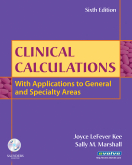|
|
|
| |
 |
|
|

|
 推薦指數:
推薦指數:





|
|
- 內容介紹
|
Clinical Calculations, 6th Edition - With Applications to General and Specialty Areas
By Joyce LeFever Kee, RN, MS and Sally M. Marshall, RN, MSN
448 pages 274 ills
Trim size 8 X 10 in
Copyright 2009
Description
Covering all four major drug calculation methods, this resource makes it easy to learn and apply drug calculations used in nursing practice today. Clear explanations of ratio & proportion, formula, fractional equation, and dimensional analysis allow you to choose the method that works best for you. A variety of realistic practice problems cover specialty areas and lifespan issues including pediatric, critical care, labor and delivery, and community settings.
Key Features
Specialty areas and lifespan issues are addressed with drug calculation problems on pediatrics, critical care, pediatric critical care, labor and delivery, and the community setting.
All four major drug calculation methods are included — ratio & proportion, formula, fractional equation, and dimensional analysis — allowing you to choose the method that works best for you.
Caution boxes provide safety alerts for various medications and their administration.
Coverage of the latest drug administration techniques and devices includes detailed explanations of oral, intravenous, intra-muscular, subcutaneous and other routes used in drug administration.
A comprehensive post-test allows you to test your knowledge of all major topics covered in the text.
Updated and easier to use, a companion CD supports the book with realistic exercises, 565 practice problems, and a comprehensive post-test.
Useful appendices include step-by-step guidelines for the administration of oral, injectable, and intravenous medications, along with at-a-glance access to the BSA Nomogram for Adults and the West Nomogram for Infants and Children.
New to this Edition
Guidelines set by The Joint Commission are followed, helping you to reduce medication errors and increase patient safety by using only the recommended abbreviations, acronyms, and symbols.
Calculations now address obese and debilitated patients by including Body Mass Index (BMI), Ideal Body Weight (IBW), and Adjusted Body Weight (ABW) methods of calculation.
Updated coverage of Pediatric Critical Care and Labor and Delivery reflects current parameters and guidelines for practice.
Coverage of hydration replacement shows how to determine the fluid needs of adults and the elderly.
Coverage of administering medication and medication solutions in the home prepares you for care of patients in home health care settings.
Coverage of calculating BMI with standard criteria helps you assess a patient’s overall health and measure obesity.
Updated drug labels, illustrations, and photos of pumps and IV
Table of Contents
Part One Basic Math Review
Part Two Systems, Conversion, and Methods of Drug Calculation
1. Systems Used for Drug Administration
2. Conversion Within the Metric, Apothecary, and Household Systems
3. Interpretation of Drug Labels, Drug Orders, MAR, Automation of Medication Dispensing Administration, “6 Rights,” and Abbreviations
4. Alternative Methods for Drug Administration
5. Methods of Calculation
6. Methods of Calculation for Individualized Drug Dosing
Part Three Calculations for Oral, Injectable, and Intravenous Drugs
7. Oral and Enteral Preparations With Clinical Applications
8. Injectable Preparations With Clinical Applications
9. Intravenous Preparations With Clinical Applications
Part Four Calculations for Specialty Areas
10. Pediatrics
11. Critical Care
12. Pediatric Critical Care
13. Labor and Delivery
14. Community
Part Five Post-Test: Oral Preparations, Injectables, Intravenous, and Pediatrics
References
Appendix A Guidelines for Administration of Medications
Appendix B Nomograms
|
|
|

